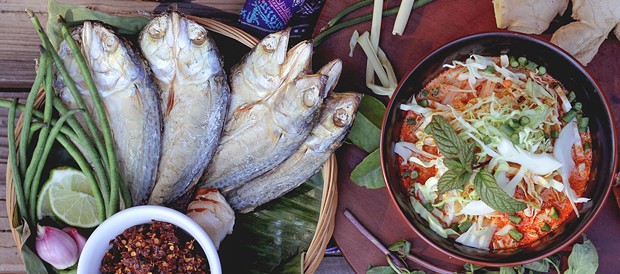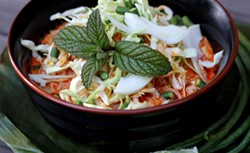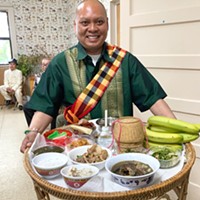[
{
"name": "Top Stories Video Pair",
"insertPoint": "7",
"component": "17087298",
"parentWrapperClass": "fdn-ads-inline-content-block",
"requiredCountToDisplay": "1"
}
]
Slipping off my shoes at the front door, I leave them with the other hundred pairs piled into a gigantic mound. Entertaining the idea of having to go on a manhunt for them later on, I turn the knob, opening the door slightly ajar to let out a thick cloud of steam. It drifts over me and I let my nose catch the last of it. It's the smell of a bright yet smoky and spicy soup cooking, and the sweet smell of glutinous rice steaming. I open the door even wider to get the full scope. It's a celebration; the Lao New Year. Men are unloading their cases of Bud Light and Hennessy into coolers. Children are filling up their squirt guns and water balloons to bless everyone with at the end of the day. The women are gathered in the kitchen; you can hear them loud and clear from the other room. Lao women have never been shy about speaking their minds and I can already guess what they'll yell to me as I walk through those kitchen doors. "Have you eaten yet?" "Are you hungry?" "Mah-der! Mah-der!" which means "Come on! Come on!" in Lao, with the intention of one hurrying over to eat.
It's in Lao people's nature to comfort their guests with food. During my 2008 trip to Laos, hoping to better understand the culture and history of my ancestry, I gained a fresh perspective about what hospitality means. Passing through a rural area of Laos, a small rice-farming family offered a place for a friend and I to stay for the night. Their home was modest and I was grateful that they would have us under their care. We sat around the ka toke (a traditional low rattan table) and the father softly spoke to us as dinner was being served.
"We are happy to have you but as you can see, we don't have much to offer," he said in his native Lao dialect. "We have a room for you to sleep. I grow rice and vegetables. My wife can make that into a meal for you. That's the most we can give you for your stay." The statement was simple, yet it filled me with gratitude. Learning that cooking is a way to welcome and comfort strangers, to make them feel at home, was a growing moment for me.
That gesture is what I want to offer when I take part in Table Collective this month. Run by Julianne Eagle, it's monthly supper club event that allows local chefs to be the architect of their own culinary stories with a prix fixe menu. The purpose of the series is to invite diners to experience food in an integrated form so that storytelling and enjoying a meal come hand in hand. I'll be cooking traditional Lao and Thai dishes that have shaped my identity and culinary palate. Each dish resonates to a different aspect of growing up Laotian-American. One of the dishes will be nam khao, a divine example of how to best use fish sauce, an ingredient that is a staple in every Southeast Asian home. This dish's complexity of sweet, sour, salty and bitter is what my maternal lineage teaches from one generation to the next. Another is khao poon, a soul-soothing, brothy, curried noodle soup almost always offered at Lao and Hmong (a distinct ethnic tribe from the mountains of Thailand and Laos) celebrations.
I'd love for everyone to have a better understanding of Lao food by cooking it at home. Saengthong Douangdara has offered to share his recipe. Saengthong is a fellow Laotian chef and instructor based in Southern California who is also on a journey to share Lao food with folks who might not otherwise have access to it. You can see more of his work — and his humor at www.saengskitchen.com and on Instagram @iamsaeng.
Khao Poon Nam Gai
Serves 2.
For the stock:
2 chicken thighs, bone-in
6 cups water
1 stalk lemongrass
5 leaves kaffir
4 slices ginger
1 tablespoon fish sauce
For the sauce:
1 tablespoon garlic, minced
2 tablespoon shallots, minced
2 tablespoon red curry paste
1 tablespoon vegetable oil
¾ cup coconut milk
For the noodles:
2 cups vermicelli noodles
For garnish:
1 bundle mint
¼ pound green or red cabbage, sliced thinly
1 lime, sliced into wedges
In a stockpot, boil the water with the chicken, lemongrass, ginger and kaffir on medium-high heat for 30 minutes. Pour in the fish sauce.
Heat another large pot on medium-low, add the oil, then red curry paste. Stir until fragrant. Toss in the garlic and shallots and sauté until they're soft and translucent.
Meanwhile, in another large pot, bring 5 cups of water to boil. This will be for the vermicelli noodles.
Pour the coconut milk into the curry paste and shallot mixture and stir. Slowly add 1 cup of chicken broth and stir. Keep adding chicken broth until the soup is to your preferred taste and spice level.
Remove the chicken meat and pound it in a mortar and pestle until it's almost a paste. You can also use your hands or forks to shred chicken if you don't have mortar and pestle available. Add the chicken to the soup.
Cook the vermicelli noodles in boiling water for 5-8 minutes. Pour the noodles into strainer and rinse them under cold water. Use tongs to grab a handful of noodles and place in bowl. Ladle soup into the noodle bowl then garnish with cabbage, herbs and a squeeze of lime juice.
Malina Syvoravong is the featured chef at the April 14 Table Collective event at the Samoa Women's Club. Peek behind the scenes on Instagram @table_collective and @m.syvodesign, and go visit www.table-collective.com for information and tickets.
Speaking of...
-
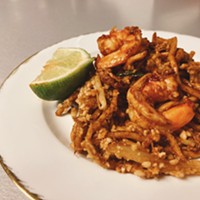
Curry Leaf's Fire-Breathing Woks
Feb 3, 2023 -
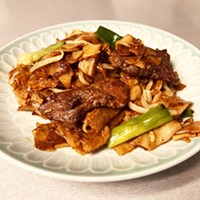
What's Good: Dipping and Frying
Feb 2, 2023 -

NCJ Preview: Election Recap and Happy Lao New Year
Jun 11, 2022 - More »
more from the author
-
Around the World, One Pot at a Time
Filipino singang — pork stew with tamarind
- Dec 20, 2018
-
Cambodian Community, Doughnuts and Prahok
And a Khmer eggplant and pork smoke-out
- Nov 8, 2018
-
The Bird and the Brine
A lesson in making the best chicken ever
- Sep 6, 2018
- More »
